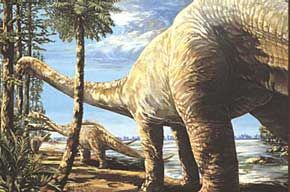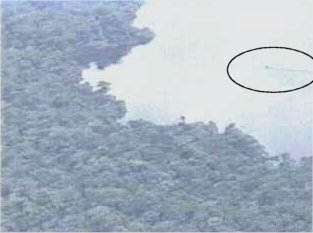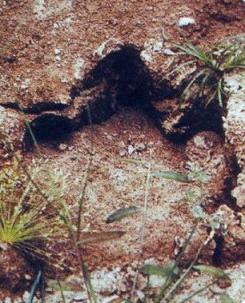|
Mokele-Mbembe
Africa's
living dinosaur?
Deep in the jungles of
The People's Republic of Congo, natives tell tales of a swamp and
river-swelling creature that they call Mokele-Mbembe. Indeed, there
are many tales of strange creatures under many names, but it is
Mokele-Mbembe that has become the most famous.
 Mokele-Mbembe,
which means 'One that stops the flow of rivers', is described as a large,
long-necked animal with no fur and rounded, three-clawed feet. Reports of
size vary from approximately 15 feet (4.5 metres) up to a whopping 75 feet
(23 metres)! It is variously described as reddish-brown to grey in colour,
sometimes seeming to have a horn or frill upon its head. Reports conflict
about whether or not the animal makes any sounds. Most reports suggest
that the beast is dumb, like a giraffe, but others contend that the
creature makes loud, roaring noises. The closest animal that
cryptozoologists can equate to Mokele-Mbembe is the sauropod dinosaur,
such as the diplodocus, cetiosaurus and apatosaurus, of the long-distant
Jurassic Age. Mokele-Mbembe,
which means 'One that stops the flow of rivers', is described as a large,
long-necked animal with no fur and rounded, three-clawed feet. Reports of
size vary from approximately 15 feet (4.5 metres) up to a whopping 75 feet
(23 metres)! It is variously described as reddish-brown to grey in colour,
sometimes seeming to have a horn or frill upon its head. Reports conflict
about whether or not the animal makes any sounds. Most reports suggest
that the beast is dumb, like a giraffe, but others contend that the
creature makes loud, roaring noises. The closest animal that
cryptozoologists can equate to Mokele-Mbembe is the sauropod dinosaur,
such as the diplodocus, cetiosaurus and apatosaurus, of the long-distant
Jurassic Age.
Stories of living
dinosaurs have trickled out of Africa for years. Just after the First
World War, Captain Leicester Stevens set out on an expedition to find 'a
brontosaurus' in the Congo. He was eager to win the $1 million reward that
The Smithsonian Institute had offered for the beast. Armed with a
Winchester rifle, he disappeared into the jungle and was never seen again.
In 1932, explorers Ivan T Sanderson and Gerald Russel reported that they
heard a roaring noise coming from close to their boat as they navigated the
Upper Cross River . A huge, monstrous head rose out of the water, then
submerged as quickly.
 More
recently, in 1980, James H Powell travelled to the Congo with Professor
Roy Mackal of the University of Chicago. They had heard the stories of
Mokele-Mbembe and arrived armed with drawings of various animals to show
eye-witnesses of the beast. Powell would show them drawings of common,
native animals, such as gorillas or okapi, which they would identify
easily. He would then show them a picture of a bear, an animal not known
in Africa, and they would be unable to recognise it. Then he would produce
a drawing of a dinosaur, a sauropod. More often than not, the natives
would immediately say that it was a drawing of Mokele-Mbembe! More
recently, in 1980, James H Powell travelled to the Congo with Professor
Roy Mackal of the University of Chicago. They had heard the stories of
Mokele-Mbembe and arrived armed with drawings of various animals to show
eye-witnesses of the beast. Powell would show them drawings of common,
native animals, such as gorillas or okapi, which they would identify
easily. He would then show them a picture of a bear, an animal not known
in Africa, and they would be unable to recognise it. Then he would produce
a drawing of a dinosaur, a sauropod. More often than not, the natives
would immediately say that it was a drawing of Mokele-Mbembe!
They heard stories from
local people about how Mokele-Mbembe would rise out of the water, its long
neck as thick as a man's leg.
On May 1 1983,
respected Congolese biologist, Marcelin Agnagna, was filming monkeys at
Lake Tele when his helpers shouted for him to join them at the water's
edge. About 300 yards (275 metres) from the shore, he saw a creature with
a long neck attached to a visible 15 feet (4.5 metres) of back protruding
above the waterline. Agnagna started filming, wading into the lake as he
did so. He got to within 200 feet (61 metres) of the animal, filming all
the time, before it slowly submerged. Unfortunately, as happens with many
cases of this nature, the film did not come out very well. Agnagna had
been filming the monkeys using his camera's macro setting and forgot to
reset it. He stuck by his story, however, and almost caused a stampede of
expeditions to the Congo, forcing the government to crack down on some
parties and sometimes being accused of favouring the more well-funded
troupes.
 In
1992, a Japanese film crew took the image on the left at Lake Tele. Is it a Mokele-Mbembe crossing the lake or just a hippo or a boat? In
1992, a Japanese film crew took the image on the left at Lake Tele. Is it a Mokele-Mbembe crossing the lake or just a hippo or a boat?

Is the photograph on
the right a footprint of a Mokele-Mbembe. It certainly matches the shape
of a sauropod print. Real or hoax?
The jungles of Africa
are vast and, even to this day, largely unexplored. Could a huge animal
such as a living sauropod go undiscovered by Western science for so long?
Remember that the Mountain Gorilla of the Virunga Range that borders
Congo, Rwanda and Uganda, was only discovered as recently as 1902. Just
when you think that all the large animals have been discovered, up pops a
new one, such as the Megamouth shark, only discovered in 1976, and only in
May of 2005, a new species of monkey, the highland mangabey, was
discovered in Tanzania. Admittedly, the monkey isn't as big as a London
bus, but its discovery certainly proves that the remote places of the
world can throw us a few surprises.
© 2005 Steve Johnson |